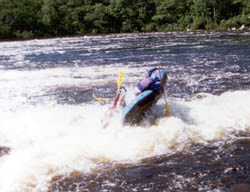

| The Value of Guided Rafting on Southern Rivers |  |
The scientists in this study wanted to quantify the value of people's vacations. For most scientists, numbers are necessary to evaluate and compare the results of their research. For some things, discovering the correct number is easy. For example, it is easy to measure how tall a tree is, or how many insects you find in a particular area. For social scientists, measuring things like people's attitudes or values is much harder. In this study, you will learn how the scientists put numbers on the value of a whitewater rafting trip.
Introduction
People have many different kinds of values. They might value their family,
home, and country, as well as their favorite t-shirt or place to play. Almost
everything has some kind of value, from an old teddy bear to your parents' car.
Some values are easy to quantify, such as the
value of a new car. This is because the car can be bought or sold for a price.
Other values, such as the value of your old teddy bear, cannot be easily
quantified. That is because you probably would not sell your teddy bear, and no
one else might not want to buy it anyway. Nevertheless, that teddy bear has a
value, which would be called its non-commodity value.
Many kinds of activities are done outside, such as hiking, birdwatching, and
canoeing. You may not pay to do these activities, but they still have a value to
you. If forest managers have to decide between two options, they want to know
how much people value the two options, even if one of the options has a
non-commodity value. For example, if a river is dammed for electric power, the
electricity has value to some people. However, the river can then no longer be
used for canoeing and rafting, which also has a value to some people.
| Economists are social scientists who try to identify
the monetary value of non-commodity resources, as well as commodity
resources. For example, they try to compare the value of things
that are not bought and sold, but are nevertheless important to people.
Economists call the value of something, especially the value that people
are willing to pay for something over its actual cost, consumer surplus.
They try to estimate consumer surplus so that decisions can be made
according to the best understanding of what people value.
Scientists Mike Bowker, D.B.K. English, and J.A. Donovan, wanted to understand the value of whitewater rafting. They felt that if they could identify a consumer surplus value for whitewater rafting, decision-makers could make better decisions in the future about how to manage free flowing rivers. |
 |
Methods
Dr. Bowker and his colleagues studied people who rafted on two rivers, the
Chattooga River in Georgia, and the Nantahala river in North Carolina. They
created a questionnaire, and mailed it to people who had taken a guided rafting
trip on either of the two rivers. The scientists asked people how far they
traveled to get to the river, how much money they spent to go rafting, and how
often they went rafting. They also asked people what their income was. They
calculated the value of the rafting trip by adding up actual costs and
estimating other costs and values. For example, they multiplied the number of
miles each person said they traveled by $ .09, and added that to the actual cost
of going rafting. Economists believe that people's time is worth something, so
the scientists added an estimate for the amount of time spent traveling and
rafting. This estimate was based on the amount of their income, or how much they
are paid to work. Because economists do not agree on how best to estimate the
value of a person's time, Dr. Bowker and his colleagues used a range of values.
They, therefore, ended up with a range of values for guided rafting on the two
rivers.
Results
Dr. Bowker and his colleagues found that guided rafting on the Chattooga
River had a consumer surplus of between $119 and $286, depending on how the
value of people's time was computed. They found that the Nantahala River's
consumer surplus value was between $89 and $191. Why the rapids on the Chattooga
River are more exciting to raft than the Nantahala River and can better compare
the value of different management options on free flowing rivers. Then, when
they make decisions, even experiences that cannot be bought or sold and be
considered.
Source: Adapted from: Bowker. M.J.,
D.B.K.English, J .A.Donovan.1996. Toward a value for guided rafting on southern
rivers. Journal of Agricultural and Applied Economics.28:423-432.
Natural Inquiry, Spring 1999 Vol 1, Number2.
[Class] [Mod 1 lesson]
![]() Copyright
2001. Northern Arizona University, ALL RIGHTS RESERVED
Copyright
2001. Northern Arizona University, ALL RIGHTS RESERVED